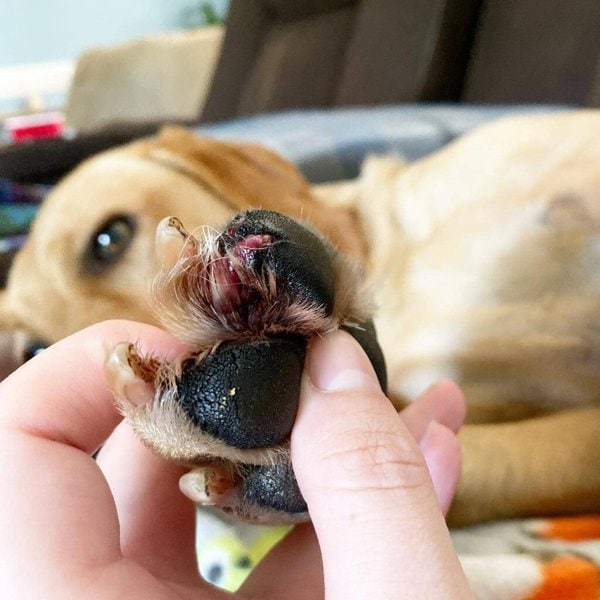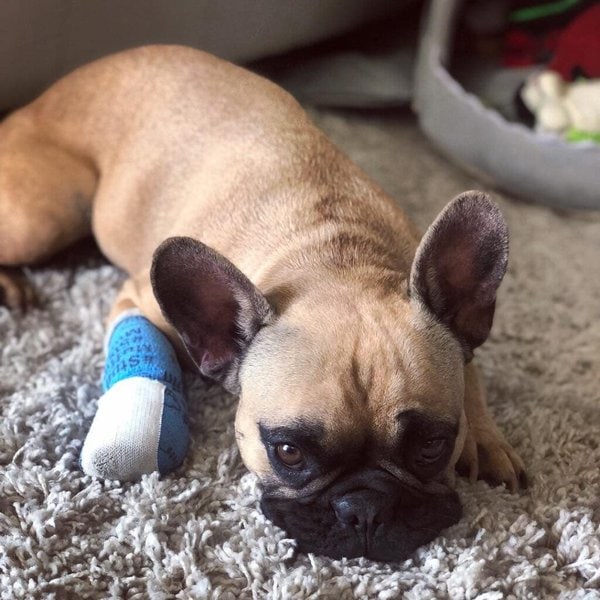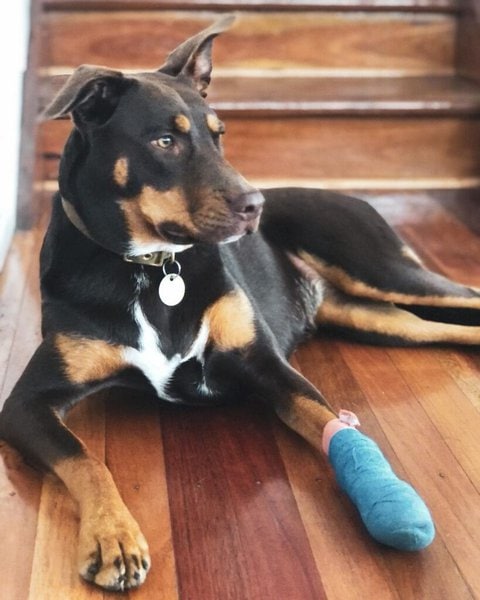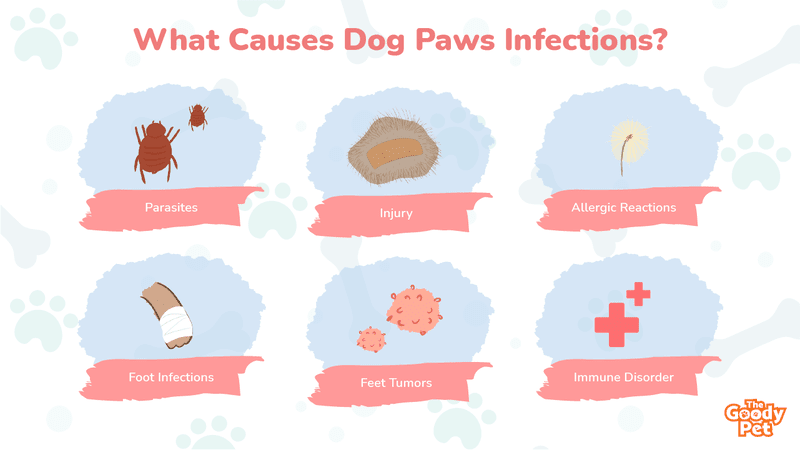It can be worrying when your dog’s paw suddenly becomes red and swollen, and even more troubling, when you don’t know the cause of this sudden reaction in your dear Fido.
That said, what causes paw infections in dogs? Dog paw infections (also referred to as dog pododermatitis) are typically caused by an injury to the paw, an allergic reaction or immune disorders. Additionally, redness and irritation of the paw can be an indicator of a bacterial or fungal foot infection, tumors or even due to the activities of parasites!
Thankfully, none of these conditions are immediately life threatening, and with prompt medical attention and treatment, your dear Fido will be back on its feet in no time. The nature of the treatments commonly used to treat paw infections in dogs, along with preventive measures to prevent bacterial and fungal infections are all covered in this article. But before we go into all this, let’s take a deeper look at the causes of redness and irritation of dog’s paws.
Why Is My Dog’s Paw Red And Irritated?
What Does An Infected Dog Paw Look Like?
Paws play an important role in determining a pooch’s health status.
And when you notice the manifestation of certain physical signs on a canine’s paws, it can be an indicator that such a doggie is suffering from an infection of the paw.
Some of the signs of an infected paw in dogs include:
- Redness of the paw
- Swelling across the entire paw, or on just one toe
- Dry pads
- Bleeding
- Growths (cysts) on the paw
- Torn nails
- Increased licking and chewing of the paws
Common causes of redness and irritation of a doggie’s paws include:
Foot Infections
There are a myriad of bacterial and fungal foot infections that may be responsible for redness of a dog’s paws, and these are some of the leading causes of pododermatitis in pooches.
In some cases, these infections can be a secondary symptom of an allergic reaction in your pooch.
Parasites
Irritation of a dog’s paw may be due to the activities of parasitic mites naturally found in canine skin. These mites typically cohabit peacefully with a pooch when its immune system is strong.
A weakening of the doggie’s immune system, however, causes the mites to go out of control, and this usually manifests as inflammation of the paws.
Allergic Reactions
Allergic reactions in dogs are often indicated by a problem with the skin. And irritation of the paw may be an indicator that your pooch is having difficulties with any of the numerous food, environmental and touch allergens.
Immune Disorder
Pemphigus, which is caused by a dog’s immune system attacking its own skin cells, can be the cause of redness and irritation of a canine’s paws.
Pemphigus in dogs typically occurs as a result of the dog’s genetic makeup or as a secondary effect of a chronic skin allergy or cancer.
Feet Tumors
Inflammation and redness of a doggie’s paws can also be an indicator of the growth of a tumor in the canine’s feet. Usually, pododermatitis caused by a tumor affects only one paw, and it is accompanied by toe ulcers and nodules on the foot.
Injury
Injury due to burning of the feet on a hot surface, running on rough or coarse ground, punctures from a thorn or insect bites may also be responsible for inflammation and redness of a dog’s paws.
In the same vein, it is possible for a doggie’s paws to become red and irritated from too much exercise.

How Can I Treat My Dogs Infected Paws?
There are several factors and medical conditions that lead to the infection of a dog’s paw; Hence, your vet will need to run a series of diagnostic tests to determine the cause of irritation in the dog’s paw, and administer proper treatment for pododermatitis.
Most times, the vet will prescribe the use of special antifungal shampoos to treat pododermatitis in dogs. In more serious cases of paw infections such as tumors, surgery may be needed to remove abnormal growths.
For infections resulting from injuries, the wound is properly washed and cleaned, and then wrapped in bandages. This bandage will draw a pooch’s attention though, so it has to be tightly wrapped to prevent your furry friend from dismantling it.
It also isn’t unusual for a vet to prescribe the use of corticosteroids to compensate for hormonal imbalances and allergies responsible for swelling of a dog’s paws.
Antibiotics And Medication
More serious paw infections caused by a bacterial infection may need to be treated with the use of antibiotics, painkillers, and anti-inflammatory medication.
Treating Yeast And Fungal Infections In Dogs At Home
If the cause of a redness and inflammation of your dog’s paw is determined to be a yeast or fungal infection, there are home remedies you can administer to alleviate your Fido’s pain, and treat the underlying infection.
Some common and effective home treatments for a yeast or fungal infection on a dog’s paws include:
Soaking Your Dog’s Foot In An Epsom Salt Bath
Epsom salt is a chemical compound that is particularly effective at treating the occurrence of yeast infections and fungal overgrowth in dogs. And its soothing capabilities can also help relieve pain resulting from the inflammation of paws in dogs.
Creating an Epsom salt bath to soak your doggie’s foot is relatively quick and easy, and it requires just two main ingredients – Epsom salt and warm water.
To draw up an Epsom salt bath for your dear fido:
- Run warm water into a bathtub.
- Add Epsom salt at a ratio of one teaspoon to every four cups of water.
- Ensure the Epsom salt dissolves properly – Stirring should help with the dissolution.
- Soak your doggie’s paws in the resulting solution for between 10 to 15 minutes.
Using A Weak Apple-Cider Vinegar Solution
By soaking a yeast-infected foot in an apple-cider vinegar solution, you can eliminate yeasts responsible for redness and inflammation in your doggie’s paws.
To prepare the solution, equal parts of apple-cider and vinegar are mixed, and the resulting mixture is applied to affected areas on the paw. Make sure to properly dry your pooch’s paws after applying the solution.
NOTE! The use of hydrogen peroxide in treating open wounds on a dog’s paws should be avoided as it can be toxic when ingested by your furry friend or cause further damage to skin cells.
How Long Does It Take A Dog’s Paw To Heal?
While most of the treatments proffered above will offer instant relief to inflammation of a dog’s paw, it may take days or weeks even, for an infected paw to heal and return to its normal condition.

How Do I Get Rid Of Bacteria On My Dog’s Paws?
Clean The Paws With Vinegar
As stated earlier, vinegar, used in conjunction with apple-cider can be effective for treating yeast infections on doggie paws. And vinegar can also be used to clean a dog’s paws to get rid of bacteria.
A solution mixed in the ratio of 1 part vinegar to 2 parts water and when applied to the affected area, is effective at making your dog’s paws inhabitable for bacteria. And coupled with its disinfecting capabilities, vinegar solution gets rid of inflammation and redness typically associated with an infected paw.
Use Coconut Oil
Coconut oil has special anti-inflammatory and anti-bacterial properties, and when mixed with a solution of apple cider and vinegar, can be quite effective at eliminating bacteria from a doggie’s paws.
As an added advantage, you won’t have to worry about your pooch licking some of the coconut oil, as it is highly beneficial to a doggie’s health.
Special Disinfectant Wipes
Another way to keep your dog’s paw bacteria-free is by cleaning the paws with pooch-specific disinfectant wipes. And as an alternative to these special dog wipes, you can also clean your furry friend’s paws with baby wipes, Clorox wipes and other moist wipes labelled safe for dog use.
However, before choosing a doggie wipe for your furry friend, you should carry out appropriate research to ensure it doesn’t contain dog allergens.
Make Use Of Dog Boots
If you’ll rather be proactive, wearing special doggie boots for your furry friend, when going on walks, is one way of minimizing your dog’s contact with dirt and bacteria.
And in addition to reducing the amount of dirt your doggie’s paws come in contact with, doggie boots also help protect your furry friend’s feet against extreme weather conditions.
What Shouldn’t You Rub On Your Dog’s Paws?
Hand Sanitizers
Hand sanitizers are the go-to option for disinfecting human hands, but you should steer clear of using a hand sanitizer on your dog’s paw. Hand sanitizer, when absorbed through a doggie’s paw, can be toxic to the pooch.
Additionally, hand sanitizers can crack a dog’s skin, leaving the door wide open to even more irritants.
And in the event that your dear fido ingests some of the sanitizer, you may be faced with a sudden medical emergency.
Rubbing Alcohol
Alcohol is useful for killing bacteria, but to be on the safer side, you should also avoid applying products containing rubbing (isopropyl) alcohol on your doggie’s paws.
Isopropyl alcohol has a drying effect on delicate dog skin, and if ingested in large amounts or inhaled, can irritate the respiratory system, cause nausea and vomiting or even induce coma in your dog!

How Often Should You Wash Your Dog’s Paws?
Washing helps keep your dog’s paws clean, and reduces the risk of your furry friend suffering from any of the numerous bacterial and fungal skin infections. Doggies are also particular about the cleanliness of your paws, and you may occasionally come across your furry friend licking its toes to get rid of dirt after a long walk.
While it is recommended that you bath your dog, at least, once every three months, there are no specific guidelines when it comes to washing a doggie’s paws. You can wash a pooch’s paws on a daily basis, and if you operate a tighter schedule, cleaning the paws twice or thrice a week is sufficient.
Ultimately though, the frequency with which you should wash your doggie’s paws depends on its activity levels. And as a rule of thumb, dogs which regularly go on hikes and long walks, will require more paw washing than indoor pooches.
The weather condition also plays an important part in determining how often you should wash your dog’s paws. Extremely hot or cold weather conditions can be harsh on a doggie’s paws; hence, you should reduce washing during these periods.
How To Wash Your Dog’s Paws?
Whenever you’re ready to clean your dog’s paws, you can do this with a mild dog shampoo or canine-friendly moist wipes.
Washing With Shampoo And Water
You can wash your dog’s paws by:
- Running a bowl of warm, soapy water using dog-friendly shampoo,
- Moistening a clean, dry towel with the soapy water, and
- Mopping dirt off the paws with the moistened towel.
You should avoid washing a dog’s paws with human shampoo or soaps, as these typically contain chemicals that are harmful to the pooch’s skin.
Using Dog Wipes
If you’re sceptical about cleaning your dog’s paw with shampoo and water on a frequent basis, you can adopt the use of disinfectant doggie wipes to keep your furry friend’s feet clean.
Additionally, it is easier to swab your canine’s feet with disposable wipes after taking walks, compared to the effort it’ll take to prepare a shampoo bath.

Related Questions
What Causes Sore Paws In Dogs? Typical causes of a sore paw pad in a dog include injury to the paw, yeast or fungal infections, over exercising, tumor growth and long or ingrown nails. Additionally, a doggie with a sore paw may be suffering an allergic reaction, a parasitic attack or arthritis.
Why Do Dogs Paws Stink? Your dog’s paw may stink and smell like Fritos due to the presence of an open sore, an infection or an injury caused by a foreign object stuck in the paw and problems with the toenail. Also, doggies don’t have sweat glands like humans, and the stinky smell from the paw is just your furry friend trying to get rid of toxic waste from its body.
How Can I Moisturize My Dog’s Paws At Home? Keeping your dog’s paw moist is essential to remedy dryness and cracking, and to prevent subsequent paw infections. And you can moisturize your dog’s paw at home, using a high-quality dog paw balm like the Baely’s Paw Shield Platinum. The Baely’s Paw Shield helps correct paw dryness and offers protection against surface friction that may cause paw irritation.





